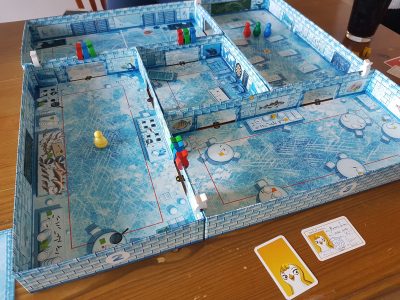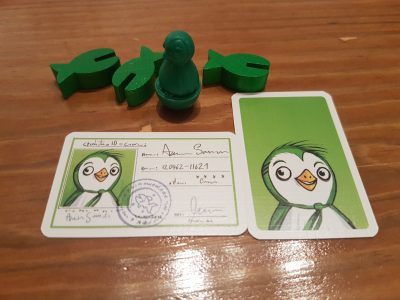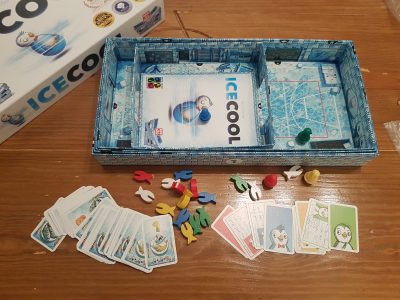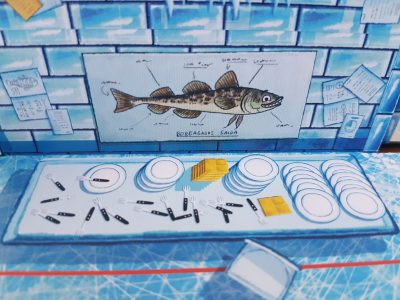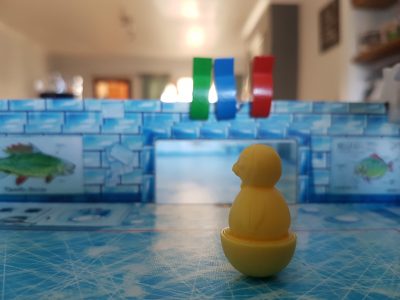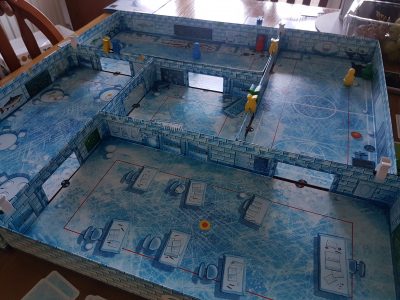With the entertaining name of Ice Cool, being a malapropism for High School, the game was off to a good start. This was even before I found that 2 – 4 players would be tasked with flicking wobbly penguins around a box like board. What do penguins want? Fish! Apparently, these are some extremely hungry penguins, and round after round they will be zooming around the school to collect fish while not getting caught by the hall monitor or catcher. It sounds like a game aimed at children or avid Pingu watchers, but is the game below it fun for all? Let’s find out.
At the offset of the game each player chooses a colour and takes the respective weighty penguin, fish, colour reminder card and an ID card. The five boxes which make up the game box are placed next to each other and pegged in place with white fish at indicated locations. After shuffling the scoring cards, the game is set up and ready to play. It really is that simple.
Ice Cool is a dexterity game, so prepare your flicks as this is how your penguin will be sliding around the school. There is a bit of a knack to doing this successfully, though trying is all part of the fun. The rulebook does give hints of how to add curve or even get the penguins to jump. Trial and error is going to be needed though and if players can laugh at their own errors a good time will be had by all. It is all made harder by the penguins actually being taller than the doors you need them to pass through!
Ice Cool utilises rounds to balance the game. Each round a different player will take up the roll of the jobsworth catcher, with the rest being runners. This creates individual rounds of 1 against all, with the aims of the catcher and the runners being different. Before the start of the round the catcher chooses a location within the kitchen to start from. In turn, the runners then place their penguin on the centre point of the classroom, the room furthest from the kitchen, and gives it a flick in any direction. Their aim is to pass through three indicated doors to collect fish that match their colour.
Once each runner has had their initial flick the catcher starts the chase, looking to hit his/her penguin into the others. Whenever contact with the catcher is made, on the catchers turn or otherwise, the catcher takes that players ID card. The turn order then goes back to the runners, so in a three player game it would be Runner – Runner – Catcher and repeat.
As players make their way around the boxes from one flick to the next they may find themselves up against a wall. Each room has an outline of a large red box where players can move to for free if they are too close to the edge. This is a only slight movement, which is about an inch from the side of the boxes. In a similar system to mini-golf it just makes flicking never impossible from being too close to the box to fit your finger. Thus, the flow of the game is maintained.
If a runner’s penguin passes completely through one of the indicated doors at any point, on their turn or knocked through by anyone, they take their fish from above the door if one is left. Whenever a fish is collected the top point card is award to the player, ranging from 1-3 points. If any runner gets all three of their fish the round ends. The other way a round can end is if the catcher has managed to bump into each of the runners once (a rule which is tweaked to twice in a 2-player game).
It may sound unfair that some fish are worth more than others, adding luck of the draw into scoring. Thankfully, this is negated by a special bonus move rule. When a point card is gained by a player they take a peak then put it face down in front of them. Whenever they have just been a player can unveil two 1’s to have an extra turn. This strangely makes scoring two points the worst, with 3 being the most points available while 1’s give the potential of an extra turn. This bonus movement works for the runners and also the catcher, so saving it until your turn as the catcher can see others gain few point cards.
At the end of the round players get one-point card for each ID card in their possession. This is how the catcher scores points but if you have held onto your ID you get a point card. Once everyone has been the catcher then the game is over. Counting up the points from the cards you received, including any revealed 1’s, reveals who wins and can claim that they have become one with Pingu.
While it might not be overly accurate to have vividly coloured penguins, the player pieces really help the aesthetics of the game enter the realms of family friendly fun. There is something enjoyable, and on the fun side of childish, watching the colourful penguins bounce around the building. The high school is parallel to this and isn’t entirely a boring monotone ice colour. Furniture is dotted around, fish posters adorn the walls, dart boards feature and all these details come together to create an environment worth looking at. Do players pay attention to these details when playing? Not really, as the game is too engaging and what room is what does blur into icy blue. They are treats noticed only when your penguin ends up wobbling next to one, undoubtedly resulting in you pointing it out to the other players.
One of the biggest game killing issues when it comes to dexterity games is if they require a serious chunk of setup time before the action starts. Ice Cool knocks this issue out of the park, or the ice rink, with the game setup and explained within a minute or two. This is ideal for teaching to younger players as they don’t have to sit around, often bored and not properly listening, before they start flicking things about. The speed of getting the game to the table isn’t just good for young children it also means it can be great for family gatherings with those easily confused aunts or uncles.
Take off the lid and what is left are the boxes that are pegged together to make the gameboard. These are made from decent, sturdy cardboard – it has a bit of give to it but nothing that is going to present an issue. For a game aimed at family gameplay this is a necessity as children aren’t always aware of causing damage to things but there shouldn’t be any problem from the box. In fact, the closest I’ve been to seeing damage caused by the game was when a penguin flow out of the boxes marginally missing a glass of ice cool “water”.
The way the game is formed in rounds, the number of which is determined by the player count, each player will add around 5-10 minutes to the overall length of the game from around 10-15 minutes with 2 players. This is only an approximate guide but as there isn’t much analysis to be done when it is your turn it is pretty much straight to the flicking. This keeps the fast-paced flow of the game and the overall game time down. The longest it has taken for a 4-player game was 35 minutes though this included setup and teardown. Naturally, if you get a good few times of people not realising it was their turn more time could clock up but I doubt a single full game would last much longer. Though, why limit yourself to only one game?!
Despite the longer duration playing at the full player count is the way forward. There is more choice for whom to initially go after for the catcher, an increased chance that one of the runners will get all their fish in a 4 player game compared to 3 and while 2 player is possible it loses some of the laughs. When playing 1 vs 1 the game gets an “I’m out to get you” feel compared to the slightly chaotic and friendlier 1 vs all. Therefore with 3 or 4 players it’s just more in keeping with when and why I’d choose to drop Ice Cool on the table.
This isn’t a game to sit around a table and play. Player’s will have to be able to move around the table to line up perfect shots, even if the shot doesn’t come off at least they can’t then blame the angle they had to take the flick from! The ability to move around the board and its size do have the potential issue of space needed. It isn’t larger than an average Ticket to Ride game but was greater than I had imagined. On the other hand, you don’t want a table that is too big that would require a lot of leaning to take shots from certain directions. It would just interrupt the game a little.
I went into Ice Cool a little concerned. Despite liking some dexterity games ones that include flicking often aren’t my cup of tea. It hasn’t converted me to the rest but it has proved me wrong about flicking as a mechanic. It is clear to see why Ice Cool has got a number of awards. It strips away any complicated rules, gets you into the game fast and just lets your childish side flourish. The downtime between turns is so short, not letting the attention slip of any player. The trial and error approach used to flick your way around the high school is great. It allows players that miserably fail a flick to laugh at themselves. The scoring is a bit luck based but the penalty of getting a 1 over a 3 is negated due to the potential for an extra turn, balancing any issue I’d raise. If you’re looking for relatively short family friend fun look no further than Ice Cool.
[Editor’s Note: Ice Cool was provided to us by Esdevium Games for review purposes. The game is currently available on 365 Games for £25.99. It is also available from local UK board game stores, find your local store here]

